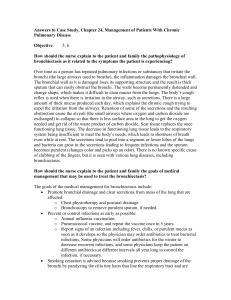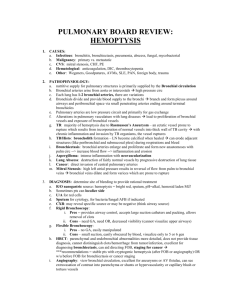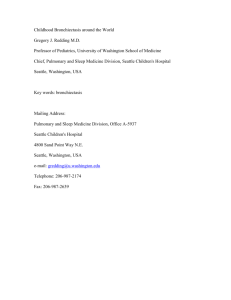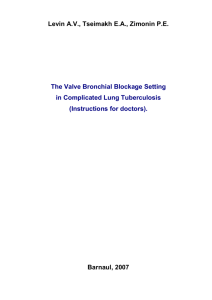Lab. 2 Respiratory System Part II
advertisement
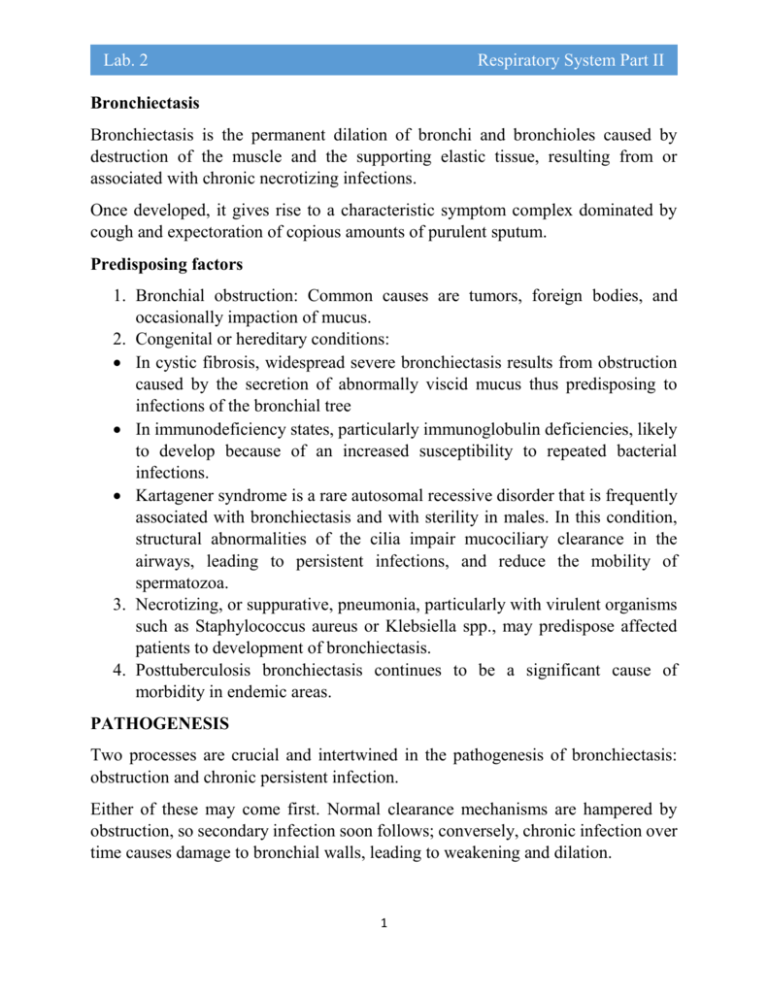
Lab. 2 Respiratory System Part II Bronchiectasis Bronchiectasis is the permanent dilation of bronchi and bronchioles caused by destruction of the muscle and the supporting elastic tissue, resulting from or associated with chronic necrotizing infections. Once developed, it gives rise to a characteristic symptom complex dominated by cough and expectoration of copious amounts of purulent sputum. Predisposing factors 1. Bronchial obstruction: Common causes are tumors, foreign bodies, and occasionally impaction of mucus. 2. Congenital or hereditary conditions: In cystic fibrosis, widespread severe bronchiectasis results from obstruction caused by the secretion of abnormally viscid mucus thus predisposing to infections of the bronchial tree In immunodeficiency states, particularly immunoglobulin deficiencies, likely to develop because of an increased susceptibility to repeated bacterial infections. Kartagener syndrome is a rare autosomal recessive disorder that is frequently associated with bronchiectasis and with sterility in males. In this condition, structural abnormalities of the cilia impair mucociliary clearance in the airways, leading to persistent infections, and reduce the mobility of spermatozoa. 3. Necrotizing, or suppurative, pneumonia, particularly with virulent organisms such as Staphylococcus aureus or Klebsiella spp., may predispose affected patients to development of bronchiectasis. 4. Posttuberculosis bronchiectasis continues to be a significant cause of morbidity in endemic areas. PATHOGENESIS Two processes are crucial and intertwined in the pathogenesis of bronchiectasis: obstruction and chronic persistent infection. Either of these may come first. Normal clearance mechanisms are hampered by obstruction, so secondary infection soon follows; conversely, chronic infection over time causes damage to bronchial walls, leading to weakening and dilation. 1 Lab. 2 Respiratory System Part II For example, obstruction caused by a primary lung cancer or a foreign body impairs clearance of secretions, providing a favorable substrate for superimposed infection. The resultant inflammatory damage to the bronchial wall and the accumulating exudate further distend the airways, leading to irreversible dilation. Conversely, a persistent necrotizing inflammation in the bronchi or bronchioles may cause obstructive secretions, inflammation throughout the wall (with peribronchial fibrosis and traction on the walls), and eventually the train of events already described. MORPHOLOGY Microscopically, fully-developed cases show the following histologic features: i) The bronchial epithelium may be normal, ulcerated or may show squamous metaplasia. ii) The bronchial wall shows infiltration by acute and chronic inflammatory cells and destruction of normal muscle and elastic tissue with replacement by fibrosis. iii) The intervening lung parenchyma shows fibrosis. iv) The pleura in the affected area is adherent and shows bands of fibrous tissue between the bronchus and the pleura. Clinical Features 1. The clinical manifestations consist of severe, persistent cough with expectoration of mucopurulent, sometimes fetid, sputum. 2. Symptoms often are episodic and are precipitated by upper respiratory tract infections or the introduction of new pathogenic agents. 3. Clubbing of the fingers may develop. Complications 1. Pulmonary hypertension, and (rarely) cor pulmonale. 2. Metastatic brain abscesses 3. reactive amyloidosis 2 Lab. 2 Respiratory System Part II Carcinomas Carcinoma of the lung (also known as “lung cancer”) is without doubt the single most important cause of cancer related deaths in industrialized countries Had strong causal relationship of cigarette smoking and lung cancer. The peak incidence of lung cancer is in persons in their 50s and 60s. At diagnosis, more than 50% of patients already have distant metastatic disease, while a fourth have disease in the regional lymph nodes. The prognosis with lung cancer is gloomy: The 5-year survival rate for all stages of lung cancer combined is about 16%, Carcinomas of the lung were classified into two broad groups: small cell lung cancer (SCLC) and non–small cell lung cancer (NSCLC) with the latter including adenocarcinomas and squamous and large cell carcinomas. The key reason for this historical distinction was that virtually all SCLCs have metastasized by the time of diagnosis and hence are not curable by surgery. Therefore, they are best treated by chemotherapy, with or without radiation therapy. By contrast, NSCLCs were more likely to be resectable and usually responded poorly to chemotherapy MORPHOLOGY Adenocarcinomas may occur as central lesions like the squamous cell variant but usually are more peripherally located, On histologic examination, they may assume a variety of forms, including acinar (gland-forming) Small cell lung carcinomas (SCLCs) generally appear as pale gray, centrally located masses with extension into the lung parenchyma and early involvement of the hilar and mediastinal nodes. These cancers are composed of tumor cells with a round to fusiform shape, scant cytoplasm, and finely granular chromatin. Mitotic figures frequently are seen. Necrosis is invariably present and may be extensive. The tumor cells are markedly fragile and often show fragmentation and “crush artifact” in small biopsy specimens. 3 Lab. 2 Respiratory System Part II Clinical Course Carcinomas of the lung are silent, insidious lesions that in many cases have spread so as to be unresectable before they produce symptoms. chronic cough and expectoration call attention to still localized, resectable disease. By the time hoarseness, chest pain, superior vena cava syndrome, pericardial or pleural effusion, or persistent segmental atelectasis. Too often, the tumor presents with symptoms emanating from metastatic spread to the brain (mental or neurologic changes), liver (hepatomegaly), or bones (pain). Overall, NSCLCs carry a better prognosis than SCLCs. Paraneoplastic syndromes. These include: 1. 2. 3. 4. hypercalcemia caused by secretion of a parathyroid Cushing syndrome (from increased production of adrenocorticotropic hormone) syndrome of inappropriate secretion of antidiuretic hormone neuromuscular syndromes, including a myasthenic syndrome, peripheral neuropathy, and polymyositis; 5. clubbing of the fingers and hypertrophic pulmonary osteoarthropathy 4







